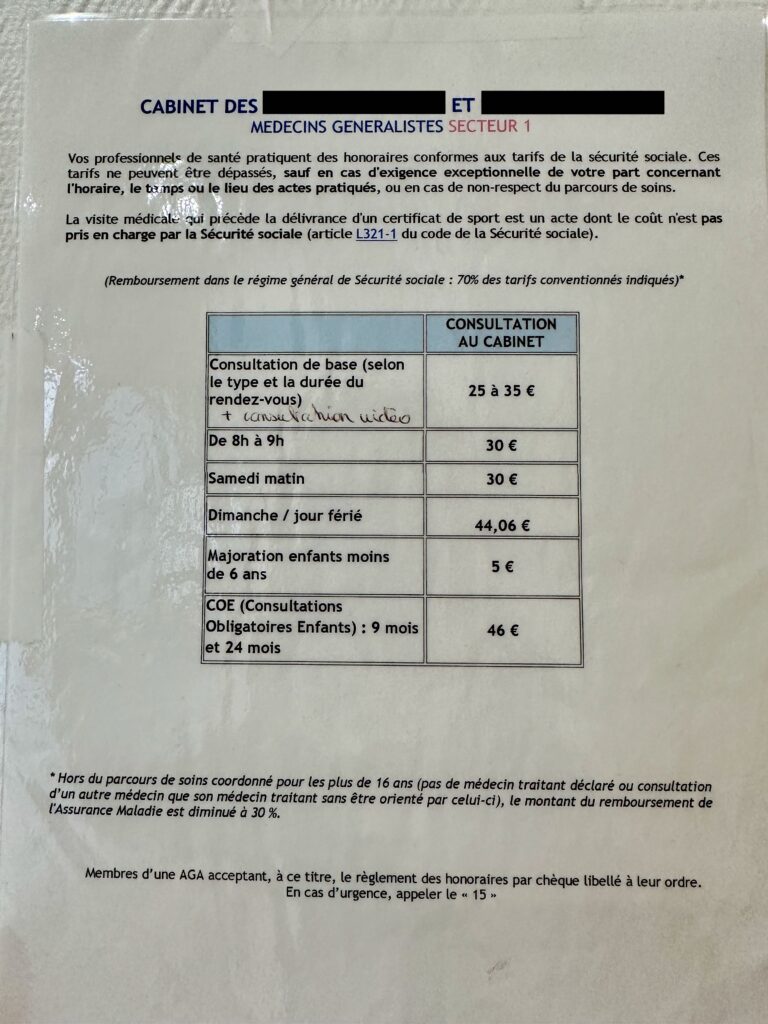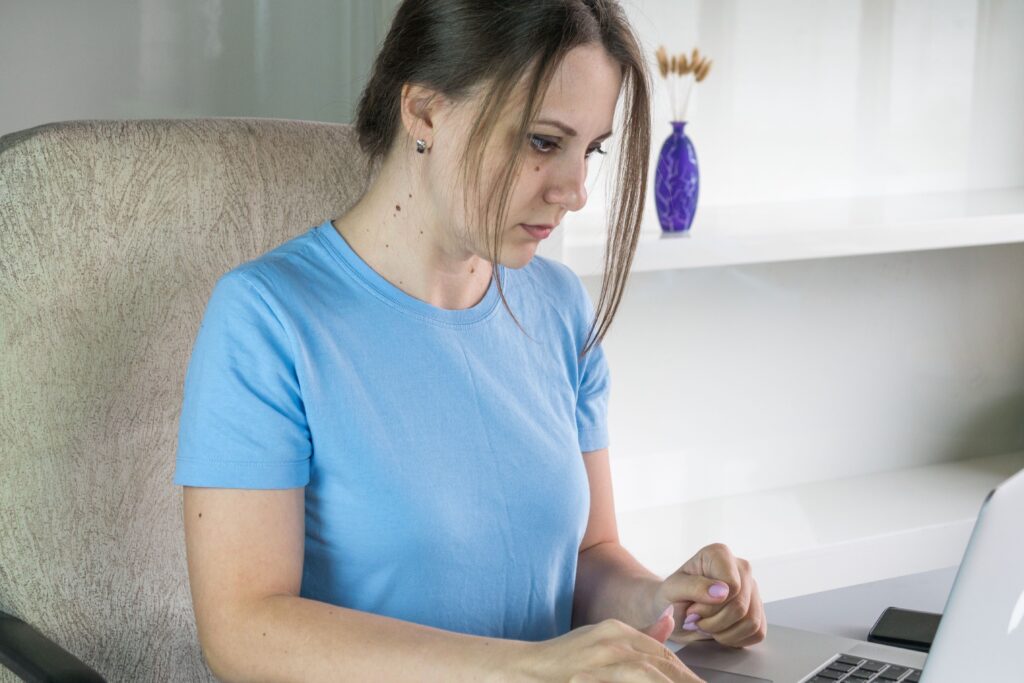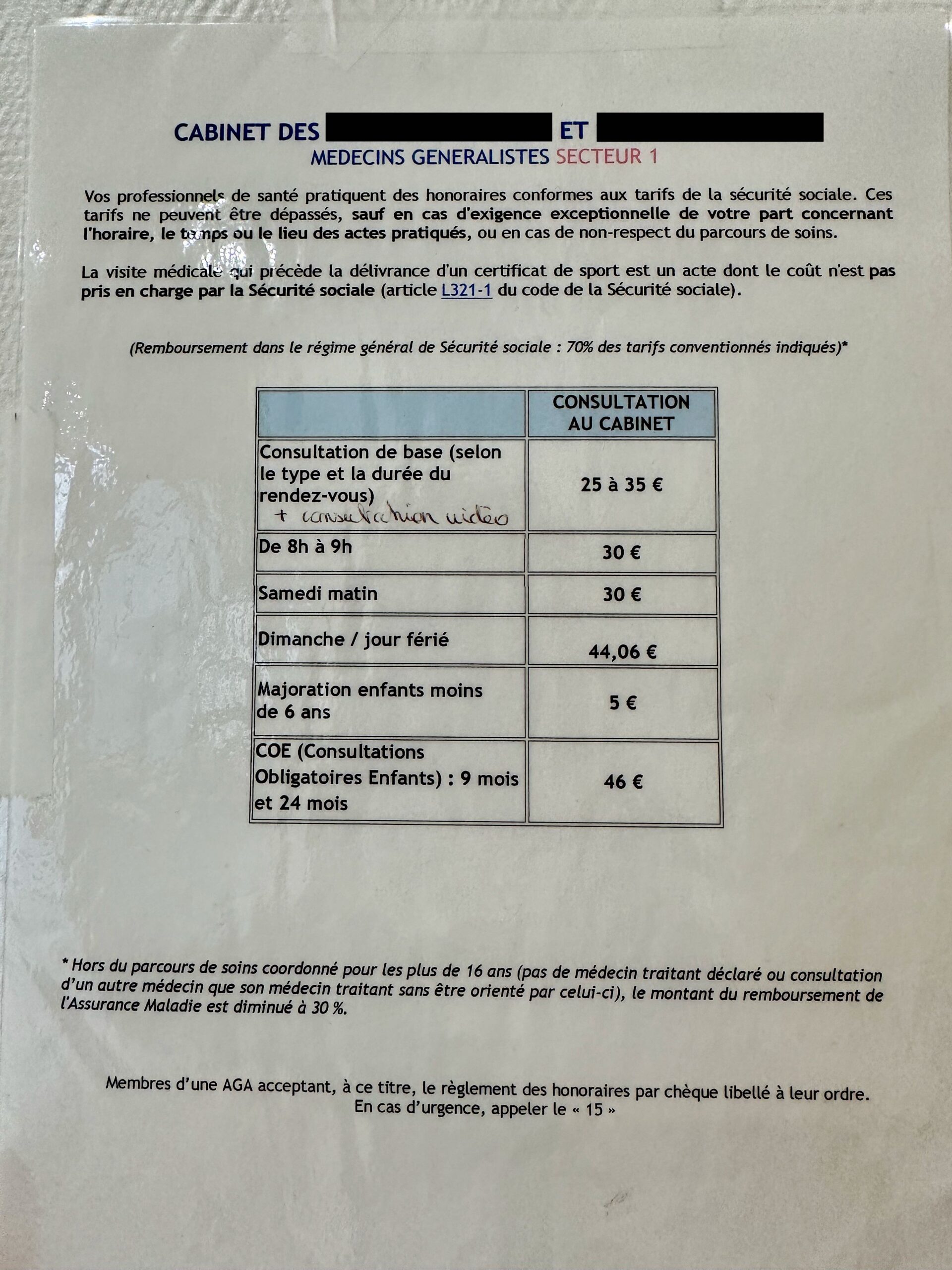This post may contain affiliate links, meaning that if you click and make a purchase, I may earn a commission at no additional cost to you. Read the full disclosure here.
Last Updated: January 24, 2024
As an American living in France, I’ve noticed many differences between healthcare in the United States and France. Going to the doctor in France is a cultural experience in and of itself. By now, I’ve been to several different types of health professionals in France, from general doctors to specialists. Here are some culture shocks I’ve personally experienced at the doctor’s office in France.

1. No Patient Intake Forms
Going to a new doctor for the first time in the U.S. means filling out several double-sided forms, giving your consent to be examined via signature, and handing over insurance information before they even see you. In the United States, you can even be turned away for not having the right kind of insurance. I can feel the weight of the clipboard now…
In France, you don’t fill out any intake forms prior to seeing the doctor, and their first question isn’t typically, “Who’s your insurance provider?” Patient information is collected during the exam whether you’ve been to this health professional previously or you are a completely new patient.
Depending on the doctor, they may ask for your carte vitale (French health insurance card) at the beginning of the appointment. The card reader can be a bit slow, so they’ll usually insert it while they ask about the purpose of your consultation. Payment is most often handled at the end of the session, after you’ve had a chance to be examined, received any prescriptions, and asked all your questions.
If you aren’t enrolled in the French national health program or don’t have any health insurance at all, this is not usually a problem. Conversely, you might find yourself on the receiving end of some raised eyebrows and concern (yes, concern!) over the fact that you’ll need to pay the full price out of pocket. Many health professionals are practically apologetic about making you pay which is something I find particularly surprising. They are offering a service after all!
Considering the high priority around health insurance and payment upon arrival at the doctor’s office in America (or sometimes even when attempting to schedule an appointment in the first place), this nonchalance in France was very shocking to me!
2. Affordable & Transparent Pricing
As a former teacher in the States, I had pretty good health insurance through my work. And yet, I was still super nervous about going to any doctor because I was never sure how much it would cost. Trying to wrap my head around in-network and out-of-network practitioners and worrying about co-pays and deductibles meant that I regularly just avoided going to the doctor altogether.
One weekend, I was very sick and I went to a walk-in clinic. I thought my insurance would cover the visit but I must have misread the fine print through my feverish brain fog. It was an out-of-network office and I ended up paying around $100 out of pocket. In the U.S., it’s nearly impossible to find clear pricing information ahead of time.
When you’re in the doctor’s office or waiting room in France, you’ll often notice a printout pinned to the wall publicly displaying the costs for various services and acts. Additionally, most health professionals in France list their rates on Doctolib, a well-known booking site for medical appointments. There are actually regulations in France to ensure that pricing is made known to patients.

Furthermore, medical fees are standardized nationally. Even if you’re a tourist in France, you’ll be charged the same price as everyone else. You just wouldn’t be reimbursed through the national system. For reference, a visit to a general practitioner is 26,50€ (about 29 USD). Those covered under the national plan get reimbursed at a rate of about 70% for most medical visits. (This is the general idea, but there is more nuance to France’s universal coverage than I can explain in a paragraph!)
Related: Pros & Cons of the French Healthcare System
While there are different levels of doctors that charge rates outside of these standard fees, pricing remains transparent and relatively affordable. It’s been eye-opening to be in a country where healthcare is largely viewed as something that should be accessible to all.
3. All-in-One Office / Exam Room and Few Support Staff
Most of my experiences arriving at the doctor’s office in the U.S. have involved speaking with a receptionist, filling out forms (as a new patient), and being directed to take a seat in the waiting room. Then you’re brought to an examining room, usually by a nurse or assistant who often starts the appointment by checking vitals, updating information, and chatting about your needs. Next, it’s time to wait again until the doctor shows up.
Everything is pretty systematic and you generally know what to do upon arrival no matter what kind of health professional you’re seeing. I’ve never been left bumbling about for too long trying to figure out what I’m supposed to do or where I’m supposed to wait.
In France, on the other hand, many a time have I been left awkwardly standing, not sure which door I need to approach or forced to verify with someone in the waiting area if I’m in the right place. The waiting area might be a room or it might be a chair in a hallway directly across from the doctor’s unlabeled office door. It can be a bit disconcerting when you first enter the building and try to figure out what is expected of you!
There isn’t always a receptionist. Secretaries for medical professionals have largely been replaced with Doctolib, an online medical appointment booking system used throughout France. Many doctors also answer their own phones themselves. I was in an appointment once when the doctor answered the phone and I had no choice but to overhear some personal patient information. This lack of medical confidentiality made me feel a bit awkward and uncomfortable!
Related: Doctolib and Other Essential Apps for Life in France
When you go to a doctor or specialist (hospitals not included), there aren’t any nurses, assistants, or even dental hygienists. You meet with the doctor directly for the entirety of your appointment.
When the doctor themself invites you into their office, the consultation begins by sitting at their desk for a chat. An examination table or chair is a short distance away for the second portion of the appointment.
It often feels like tight quarters and while I’ve never been concerned about the cleanliness, there is not always the same level of sterility in the room that one might be accustomed to in the United States. Let’s just say that I’ve been to some doctor’s offices in Paris that felt more like converted living rooms with nice wall hangings, warm lighting, parquet floors, and rugs to boot.
Ok, this might have been a bit of an exaggeration! There’s a wide spectrum of doctors’ offices in France, from traditional to modern to shabby chic. On the whole, there is a tangible difference between what feels like a very formal medical environment on the American sides of things to what feels like a very informal medical environment on the French side.

By the way, health professionals in France (outside of hospitals) aren’t usually wearing scrubs or white coats with a stethoscope around their necks. Most of the doctors and specialists I’ve seen in France wear casual or business casual clothing. The overall level of informality in the medical environment certainly threw me for a loop!
4. Perfunctory Bedside Manner
In the United States, I frequently had the impression that my regular doctors knew me to an extent on a personal level. They’d ask specific questions about my life and how my job was going. My gynecologist, whom I only saw once per year, was no exception. Of course, I realize that this is all an illusion. They probably just took a look at the notes in my chart before walking in the room. Nonetheless, their friendliness definitely put me at ease before an appointment.
On the other hand, in France, when attending appointments on my own or accompanying my (French) husband, I’ve noticed that doctors here don’t often ask many questions that would be considered personal or that would lead to small talk or a connection later on. Obviously, I can’t speak for all doctors in France as this is also a matter of personality!

As a foreigner, I do get the impression that many of my doctors have taken more of an interest in me because I’m a bit different than their usual patients. Many of the health professionals that I’ve seen have been friendly. I usually manage to crack a joke or at least get them to laugh when I make a fool of myself. You see, I have a tendency to use somewhat crass, informal language when I don’t have the “correct” medical terminology at my fingertips, and this can be comical. Imagine an adult discussing their boogers with the doctor instead of referring to it as mucus, for example.
It’s important to note that most general medical appointments only last 15 minutes, so they don’t really have too much time for chitchat! They have a job to do. However, if you’re used to a doctor taking time to get to know you on a personal level, it can all feel a bit abrupt and even harsh.
5. Lack of Gowns When Stripping Down
In the United States, there is a great deal of care around making sure that the patient is comfortable and has privacy. You’re usually handed a gown or other appropriate covering depending on the nature of the examination. Taking off your clothes and transitioning to the examination table is done behind a partition or closed doors. Before they come in the room or open the partition, the doctor usually orally verifies if you are ready.
This is just not what happens in France. You know how I was saying that it’s a combo office/examination room and the examination table is right next to the desk? Yes, well… Brace yourself because the doctor isn’t going anywhere while you undress!
- Did you get called in for an X-ray with OFII for your visa validation process? Remove everything on top and walk up to the X-ray machine!
- Is it time for your annual checkup with the gynecologist or midwife? Drop your pants.
- Getting your beauty marks checked at the dermatologist? Strip completely (you can probably keep your underwear on) and walk your fanny right over to the table.
- Going to the podiatrist? Depending on what you’re there for, you might need to take your pants off so that they can observe your alignment when walking.
Quickly, quickly now. Remember, we only have 15 minutes to get it all done.
There’s no time for a gown. However, with the time limit, you can at least rest assured that you’ll only be naked very briefly! Most often, there is no partition for any kind of semblance of privacy. No matter, they’re going to see everything anyway, right?
Of course, the vulnerability of nudity can certainly be a delicate issue for many people for any number of reasons. Combined with the perfunctory bedside manner, this type of experience at the doctor’s office in France can feel brusque and stressful. This is especially true if you don’t know what to expect for your first time!
Did you experience any culture shocks when going to the doctor in France? Tell us in the comment section below!


